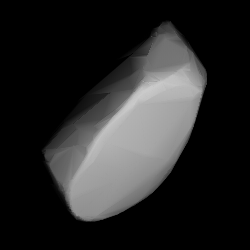Top Qs
Timeline
Chat
Perspective
1219 Britta
Main-belt asteroid From Wikipedia, the free encyclopedia
Remove ads
1219 Britta, provisional designation 1932 CJ, is a stony background asteroid from the inner regions of the asteroid belt, approximately 11 kilometers (7 miles) in diameter. It was discovered on 6 February 1932, by German astronomer Max Wolf at the Heidelberg-Königstuhl State Observatory in southern Germany.[1] The likely elongated S-type asteroid has a rotation period of 5.57 hours.[4] Any reference of its name to a person is unknown.[2]
Remove ads
Orbit and classification
Britta is a non-family asteroid of the main belt's background population when applying the hierarchical clustering method to its proper orbital elements.[5] Based on osculating Keplerian orbital elements, the asteroid has also been classified as a member of the Flora family (402), a giant asteroid family and the largest family of stony asteroids in the main-belt.[4]
It orbits the Sun in the inner main-belt at a distance of 1.9–2.5 AU once every 3 years and 3 months (1,203 days; semi-major axis of 2.21 AU). Its orbit has an eccentricity of 0.12 and an inclination of 4° with respect to the ecliptic.[3]
The asteroid was first observed as A904 SB at Heidelberg Observatory in September 1904. The body's observation arc begins with its official discovery observation at Heidelberg in February 1932.[1]
Remove ads
Naming
This minor planet is named after a common German female name. Any reference of this name to a person or occurrence is unknown.[2]
Unknown meaning
Among the many thousands of named minor planets, Britta is one of 120 asteroids, for which no official naming citation has been published. All of these low-numbered asteroids have numbers between 164 Eva and 1514 Ricouxa and were discovered between 1876 and the 1930s, predominantly by astronomers Auguste Charlois, Johann Palisa, Max Wolf and Karl Reinmuth.[18]
Remove ads
Physical characteristics
Summarize
Perspective
Britta has been characterized as a stony S-type asteroid in both the Tholen- and SMASS-like taxonomy of the Small Solar System Objects Spectroscopic Survey (S3OS2).[17]
Rotation period
Several rotational lightcurves[a] of Britta have been obtained from photometric observations since the 1980s.[9][10][11][12][13][14] The consolidated lightcurve analysis results give a rotation period of 5.575 hours with a brightness amplitude between 0.48 and 0.75 magnitude, indicative of an elongated shape (U=3).[4]
Spin axis
Modeled photometric data from the Lowell Photometric Database (LPD) and the robotic BlueEye600 Observatory, gave a concurring period of 5.57556 and 5.57557 hours, respectively.[15][16] Both studies determined two spin axes of (72.0°, −66.0°) and (241.0°, −66.0°), as well as (61.0°, −2.0°) and (223.0°, −68.0°) in ecliptic coordinates (λ, β).[15][16]
Diameter and albedo
According to the surveys carried out by the Infrared Astronomical Satellite IRAS, the Japanese Akari satellite and the NEOWISE mission of NASA's Wide-field Infrared Survey Explorer, Britta measures between 9.860 and 11.76 kilometers in diameter and its surface has an albedo between 0.223 and 0.346.[6][7][8] The Collaborative Asteroid Lightcurve Link derives an albedo of 0.2629 and a diameter of 11.31 kilometers based on an absolute magnitude of 11.8.[4]
Notes
- Lightcurve plot of (1219) Britta by R. D. Stephens (2014): rotation period 5.573±0.001 hours. 474 data points. Quality Code of 3. Summary figures at the LCDB and Center for Solar System Studies – CS3 Lightcurves Page
References
External links
Wikiwand - on
Seamless Wikipedia browsing. On steroids.
Remove ads

